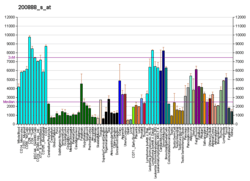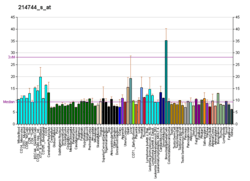60S ribosomal protein L23
60S ribosomal protein L23 is a protein that in humans is encoded by the RPL23 gene.[5][6]
Ribosomes, the organelles that catalyze protein synthesis, consist of a small 40S subunit and a large 60S subunit. Together these subunits are composed of 4 RNA species and approximately 80 structurally distinct proteins. This gene encodes a ribosomal protein that is a component of the 60S subunit. The protein belongs to the L14P family of ribosomal proteins. It is located in the cytoplasm. This gene has been referred to as RPL17 because the encoded protein shares amino acid identity with ribosomal protein L17 from Saccharomyces cerevisiae; however, its official symbol is RPL23. As is typical for genes encoding ribosomal proteins, there are multiple processed pseudogenes of this gene dispersed through the genome.[6]
References
- 1 2 3 GRCh38: Ensembl release 89: ENSG00000125691 - Ensembl, May 2017
- 1 2 3 GRCm38: Ensembl release 89: ENSMUSG00000071415 - Ensembl, May 2017
- ↑ "Human PubMed Reference:".
- ↑ "Mouse PubMed Reference:".
- ↑ Herault Y, Michel D, Chatelain G, Brun G (Aug 1991). "cDNA and predicted amino acid sequences of the human ribosomal protein genes rpS12 and rpL17". Nucleic Acids Res. 19 (14): 4001. doi:10.1093/nar/19.14.4001. PMC 328500. PMID 1861993.
- 1 2 "Entrez Gene: RPL23 ribosomal protein L23".
Further reading
- Wool IG, Chan YL, Glück A (1996). "Structure and evolution of mammalian ribosomal proteins". Biochem. Cell Biol. 73 (11–12): 933–47. doi:10.1139/o95-101. PMID 8722009.
- Berchtold MW, Berger MC (1991). "Isolation and analysis of a human cDNA highly homologous to the yeast gene encoding L17A ribosomal protein". Gene. 102 (2): 283–8. doi:10.1016/0378-1119(91)90091-O. PMID 1874450.
- Yaseen NR, Blobel G (1997). "Cloning and characterization of human karyopherin β3". Proc. Natl. Acad. Sci. U.S.A. 94 (9): 4451–6. doi:10.1073/pnas.94.9.4451. PMC 20743. PMID 9114010.
- Kenmochi N, Kawaguchi T, Rozen S, et al. (1998). "A map of 75 human ribosomal protein genes". Genome Res. 8 (5): 509–23. doi:10.1101/gr.8.5.509. PMID 9582194.
- Yoshihama M, Uechi T, Asakawa S, et al. (2002). "The Human Ribosomal Protein Genes: Sequencing and Comparative Analysis of 73 Genes". Genome Res. 12 (3): 379–90. doi:10.1101/gr.214202. PMC 155282. PMID 11875025.
- Strausberg RL, Feingold EA, Grouse LH, et al. (2003). "Generation and initial analysis of more than 15,000 full-length human and mouse cDNA sequences". Proc. Natl. Acad. Sci. U.S.A. 99 (26): 16899–903. doi:10.1073/pnas.242603899. PMC 139241. PMID 12477932.
- Bouwmeester T, Bauch A, Ruffner H, et al. (2004). "A physical and functional map of the human TNF-alpha/NF-kappa B signal transduction pathway". Nat. Cell Biol. 6 (2): 97–105. doi:10.1038/ncb1086. PMID 14743216.
- Shi Y, Zhai H, Wang X, et al. (2004). "Ribosomal proteins S13 and L23 promote multidrug resistance in gastric cancer cells by suppressing drug-induced apoptosis". Exp. Cell Res. 296 (2): 337–46. doi:10.1016/j.yexcr.2004.02.009. PMID 15149863.
- Dai MS, Lu H (2004). "Inhibition of MDM2-mediated p53 ubiquitination and degradation by ribosomal protein L5". J. Biol. Chem. 279 (43): 44475–82. doi:10.1074/jbc.M403722200. PMID 15308643.
- Dai MS, Zeng SX, Jin Y, et al. (2004). "Ribosomal Protein L23 Activates p53 by Inhibiting MDM2 Function in Response to Ribosomal Perturbation but Not to Translation Inhibition". Mol. Cell. Biol. 24 (17): 7654–68. doi:10.1128/MCB.24.17.7654-7668.2004. PMC 506971. PMID 15314173.
- Jin A, Itahana K, O'Keefe K, Zhang Y (2004). "Inhibition of HDM2 and Activation of p53 by Ribosomal Protein L23". Mol. Cell. Biol. 24 (17): 7669–80. doi:10.1128/MCB.24.17.7669-7680.2004. PMC 506972. PMID 15314174.
- Gerhard DS, Wagner L, Feingold EA, et al. (2004). "The Status, Quality, and Expansion of the NIH Full-Length cDNA Project: The Mammalian Gene Collection (MGC)". Genome Res. 14 (10B): 2121–7. doi:10.1101/gr.2596504. PMC 528928. PMID 15489334.
- Rush J, Moritz A, Lee KA, et al. (2005). "Immunoaffinity profiling of tyrosine phosphorylation in cancer cells". Nat. Biotechnol. 23 (1): 94–101. doi:10.1038/nbt1046. PMID 15592455.
- Rual JF, Venkatesan K, Hao T, et al. (2005). "Towards a proteome-scale map of the human protein-protein interaction network". Nature. 437 (7062): 1173–8. doi:10.1038/nature04209. PMID 16189514.





